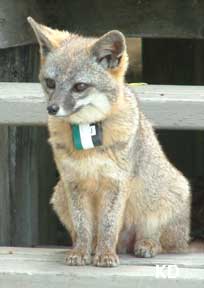 |
| photo courtesy of Kevin Schafer |
The island fox pictured on the ground is wearing a radio tracking collar. To date members of the community like you have funded 56 radio tracking collars that allow field biologists to track island fox activity and respond quickly when an individual island fox dies. Early response enables scientists to determine the cause of death: golden eagle attack, disease, car strike or something unexpected. The faster biologists can respond to a specific threat, the quicker appropriate action can be taken to protect living island foxes.
Helping island foxes can take many forms:
- $250 funds a radio tracking collar on an individual island fox for one year
- $120 puts a “Watch for Foxes” sign along an area of road where foxes are being hit by cars. This is currently the number one cause of island fox fatality on Santa Catalina, San Clemente and San Nicolas Islands. (Five signs are currently needed on Santa Catalina.)
- $50 provides the necessary testing of a blood sample to determine whether young island foxes are developing immunity to naturally occurring diseases
- $10 vaccinates an island fox against its two greatest threats - rabies and distemper.
- $10 provides for an identification microchip for an individual island fox
General donations to Friends of the Island Fox support our education efforts in Santa Barbara, Ventura and Los Angeles Counties. (Island Fox Ambassador Schools, Island Fox in the Classroom, Community Fox Talk Programs) Long-term population recovery demands that local citizens understand the threats to island foxes and the important role foxes and people play in maintaining a balanced ecosystem on the islands. You can play an active role in the continued success of saving the island fox by donating today.



















